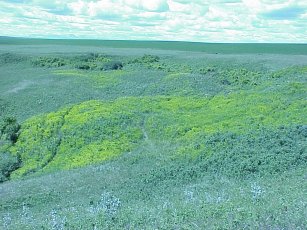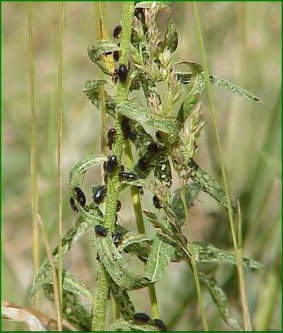Sustainable Crop Protection
Results from the Pesticide Risk Reduction Program
Some Canadian grazing lands are threatened by invasive plants, usually introduced from abroad, that have been able to flourish due to a lack of the herbivores native to the area of origin which would normally limit their spread. One of the most serious of these invasive plants is Leafy Spurge (Euphorbia esula L.), introduced from Europe and now infesting an estimated 2 million hectares of rangeland and riverside habitats in North America. The weed crowds out native species and produces a sap which is toxic to cattle, requiring control measures. The traditional approach of using herbicides has some drawbacks including high cost due to the large areas and difficult terrain to be treated. In addition, there are environmental concerns associated with the use of herbicides in many locations because of the close proximity of spurge-infested areas to water bodies.

Leafy spurge growing on rangeland in Alberta
Work was undertaken by Agriculture and Agri-food Canada's (AAFC) research centre in Lethbridge, Alberta, to develop a classical biological control approach for leafy spurge. This involved introducing natural insect enemies of the weed into Canada, from their native habitats in Europe. The overall goal of this approach is to establish a balance in the Canadian ecosystem between the weed and its enemies that will, over time, result in the reduction of weed populations to acceptable levels.
There have been 14 foreign insects released against leafy spurge with the most successful being five flea-beetle species of the genus Aphthona (Bourchier et al. 2002). Particularly, Aphthona lacertosa have had a dramatic impact on leafy spurge. This beetle was first released in Canada in 1991 after intensive host-range screening to ensure it was specific to the target weed, leafy spurge. Aphthona lacertosa larvae feed on the roots of the weed, while the adult beetles, when at high densities, consume the above ground portion of the plant before it produces seeds.
The Pesticide Risk Reduction Program of AAFC's Pest Management Center funded work from 2003 to 2007 to improve the success of releases of this beetle and to increase the distribution of release sites in leafy spurge infested areas.

Beetles eating spurge

Adult Aphtona lacertosa
Approach
Between 2004 and 2007, 125 releases of Aphthona lacertosa were conducted. Following those releases, each year, beetle densities and vegetation changes were assessed at each release site. Overwintering conditions at the study sites (snow cover, air temperature, ground surface temperature, soil temperature) were collected to determine the climatic limits to beetle population growth in the province.
Site information, including Global Positioning System (GPS) coordinates and site attributes for all releases associated with this project have been entered into a comprehensive release database for Alberta. This database enables appropriate timing of site monitoring to assess longer-term impacts of the biocontrol agents on their target weeds. In addition, all available paper records for historical biocontrol releases in Alberta have been entered into the database. This provides easy access to information on over 1200 releases targeting 19 weeds, including leafy spurge, with over 50 insect species, dating back to 1965.
To increase adoption of Aphthona lacertosa as a biocontrol agent in a strategy to suppress leafy spurge, approximately 10 to 15 demonstration release sites, both urban and rural, were added each year. These releases were conducted with direct, one on one interaction with landowners. Each site was checked in the year after release for beetle establishment and recommendations were provided for future monitoring of the site and potential redistribution of the beetles.
Benefits
A number of benefits are apparent as a result of this successful biological control program:
- The solution is self-perpetuating, and there is little requirement for human labour.
- The solution is cost effective for the landowner, reducing expenses associated with weed management in difficult to reach areas.
- The solution is soft on the environment, and does not put sensitive habitats including waterways at risk from exposure to chemicals.
The classical biological control approach is sustainable and cost-effective. Flea beetle populations constantly renew themselves and when a population is well established, the insects move to a new site infested by leafy spurge without human intervention. An ecological balance is eventually achieved between the beetles and the host plant, thereby reducing leafy spurge populations to an acceptable level.
In contrast, the control of leafy spurge with chemicals can cost growers as much as $1000 per hectare including herbicide and labour with repeated applications required in areas near streams where only less persistent herbicides can be used.
Biological control using beetles significantly reduces the risks related to herbicide residues that can persist in the soil or be washed into streams. For example, it is estimated that the use of Aphthona lacertosa to control leafy spurge replaces up to 2.2 kilograms per hectare of picloram's active ingredient which would otherwise be released into the environment where it may have undesirable impacts on native species. Flea beetles are highly specific to their host, leafy spurge, and do not adversely affect other plant species. The use of flea beetles allows for the re-establishment and conservation of the biodiversity of plant species present in the environment.
The knowledge gained through this study has improved the selection of Aphthona lacertosa release sites to favour the survival and growth of populations of this insect and promote the further proliferation of this beneficial insect on private and public lands, reducing the requirement for chemical interventions.
For more information about biological control of leafy spurge, please contact Dr. Rob Bourchier.